Brain stimulation in people with neglect
Marij Middag (PhD Candidate) and Teresa Schuhmann (Professor of Clinical Applications of Non-invasive Brain Stimulation) from the Department of Cognitive Neuroscience at the Faculty of Psychology and Neuroscience, have recently published their paper Alpha transcranial alternating current stimulation as add-on to neglect training: a randomised trial (also co-authored with Alexander Sack and Caroline van Heugten) in Brain Communications from Oxford Academic. We spoke to Schuhmann about their research
TACS
TACS: Transcranial Alternating Current Stimulation, the technique Schuhmann and her team work with, uses electrodes that are placed on the head, between the electrodes a current flows in a certain rhythm. ‘The cells in your brain (neurons) talk to each other through electricity, when the neurons send a signal we call this firing. This firing happens at different rhythms for different tasks. With TACS, we can strengthen those rhythms in the brain’.
Research has taught us that when we focus our attention on something, certain rhythms can be seen in specific areas of the brain. ‘We have found that in healthy people, we can shift their attention a bit (from, say, left to right), by stimulating other areas in their brains through TACS. That's pretty cool, but we do it mainly to answer the question: how does attention work?’.
Neglect
‘A common condition in people who have had a stroke is neglect. This means they ignore a ‘side’ of the world, for them that side no longer exists, often it is the left side. This has quite incredible consequences. If you ask them to draw a clock, they will draw all 12 numbers of the clock on one side. If they shave, they only shave the right side. They also eat only the right half of their plate’. For a long time, it was thought that it was a problem with vision. That people do not see the left side. However, we now know that this is not correct. The eyes perceive everything, the area in the brain responsible for seeing is intact, only the ability to shift attention to one side is no longer there.
Outside of these daily obstacles this ignoring half the world naturally leads to bigger problems, when someone participates in traffic, or has to look after children.

Attention
As one side of the brain stops working properly, the other side starts working extra hard to compensate. ‘In previous studies, we used TACS to calm down the ‘healthy’ side of the brain, giving the affected side a chance to cooperate again. We were able to show then that after just one stimulation, you saw improvement. The idea is that if you apply TACS regularly over a period of 6 weeks, along with a training that teaches you to shift your attention that you will see the brain recover permanently.’
Together with Marij Middag, the publication's first author, the authors wanted to test this clinically as a therapy. ‘There are already therapies for people with neglect, assignments and exercises they can do to see improvement. Some people recover without therapy. But there are some patients who experience chronic neglect. This population is what our research focuses on, what to do when all other means don't work.’

The therapy
These chronic patients receive digital cognitive training in combination with TACS. ‘Stimulation alone is not enough to see real improvement. TACS gets the system going again, but you then have to actually train through exercises. For six weeks, Middag travelled all over the country, three times a week, to administer TACS. And we are very happy to see significant improvement in the patients. It's special that we can do something for the people for whom there was no possibility before’.
The TACS machines are small, portable and easy to use. ‘This gives people the chance to use it themselves at home, for example. Nurses can also learn it quickly, so the application of the therapy is very feasable, and we hope we can do more studies proving its usefulness to give it a place as a treatment method.’
Also read
-
How do we imagine? ERC Advanced Grant for Prof. dr. Rainer Goebel (FPN)
FPN’s prof. dr. Rainer Goebel has been awarded an ERC Advanced Grant of € 2,5M for his research project Reading the Mind’s Eye: AI inspired personalised brain models of mental imagery. Goebel is among 255 researchers (out of 1829 applications in all domains) in Europe to receive the grant, and he is...

-
“Change the work, not the workers”
Professor Fred Zijlstra is set to retire in May. How does he look back on his career? What is his take on current developments in the field of work and organisational psychology? And how can we, as a society, best organise work—now and in the future?

-
Contribution to society | Fred Zijlstra
On 8 June, Professor Fred Zijlstra will bid farewell to the Faculty of Psychology and Neuroscience and his Chair in Work and Organisational Psychology. In his farewell address, he will look back on the work that has fascinated him for so long. We met him in his office to get a preview of this...
